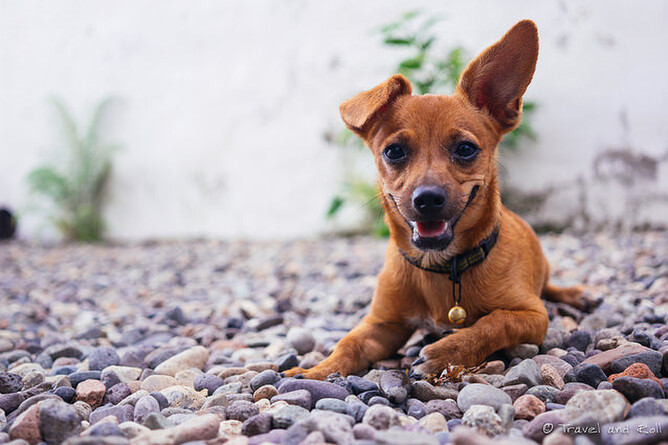Photo courtesy of Travel and Roll
Get to know your pup’s behaviour
When it comes to communicating with our pups, we can be left guessing what they’re trying to say. You might often wonder, “why does my dog bow his head?” or “why does my dog stare at me?”
Lucky for us, there are loads of experts out there studying dog behaviour so we can get closer to understanding our furry friends.
Cesar Milan says to pay attention to key body features when trying to figure out what your pup is feeling:
“The higher a dog’s head, ears and tail are, the more dominant it is feeling; and the lower they are, the more submissive or uncertain the dog is feeling.”
While a tail wag is easy enough to understand, what about the other little behaviours our dogs show? Whether it be wanting to play, feeling scared, or feeling angry, becoming familiar with and being certain of these signs is a great way to get closer to your best friend.
Here’s a helpful guide deciphering your pup’s moves:
1. The greeting stretch
The pose: Front legs stretched out. Hind legs raised. Calm attitude.
What it means: This is your pup’s way of saying “hello”. They’ll often only do it to people they feel really comfortable around. So if your pup greets you in the morning with this pose, be happy! It means they feel safe and familiar with you. Try responding by calling them to you.
2. Let’s play!
The pose: Front legs and shoulders low. Hind legs raised. Wagging tail and excited attitude.
What it means: This is what some dog trainers call the ‘play bow’ and means exactly that. A similar pose to the greeting stretch but more animated and often with their tail wagging. When your pup is feeling playful, they’ll often pose this way. It’s their way of asking “will you play with me?”
3. Hey, friend!
The pose: Two dogs circling one another, often sniffing each others behinds. Excited and curious attitude.
What it means: Dog’s will often greet each other by circling and sniffing each other. This is a classic sign of curiosity among dogs and is a great way for them to socialise.
4. Hey, pay attention to me!
The pose: Your dog is standing or sitting still, staring at you without looking away. There’s no hint of aggression in their body language.
What it means: A dog that’s staring at you typically wants your attention. They may not be sure how to express what is they want, so they stare and wait. But there could be a few other reasons for this prolonged gaze. If you’ve issued a new command, your dog might be confused about what it is you want them to do. Be patient, they’re still learning. Or perhaps, you’re just talking to your pet but not using any key training phrases. These one-sided chats are soothing for you but may leave your pup wondering what’s up. Lastly, your dog may be waiting for direction. If your dog can sense you’re going to ask for something, he or she may be patiently waiting.
5. I feel shy
The pose: Crouched low to the ground. Ears drawn back. Timid attitude.
What it means: When your pup is feeling shy or nervous, they’ll often cower low and avoid interaction. When this happens, avoid leaning over them. Try kneeling down to get on their level and wait for them to approach you.
6. I feel threatened
The pose: Stiff body. Ears perched and hair raised. Aggressive attitude.
What it means: If a dog is feeling aggressive or suspicious they’ll show it through their body language. If you see your dog behaving this way, remain calm. If they become aggressive with another dog, try startling them with a loud clap or shout.
While these might be some typical examples of dog behaviour, they are by no means definitive.
Every dog is different and has their own unique behaviours. Getting to know your dog’s signs can take time, but this is a great way to better understand your four-legged friend.

